冀教版8年级英语下lesson15教案
- 格式:doc
- 大小:33.50 KB
- 文档页数:7
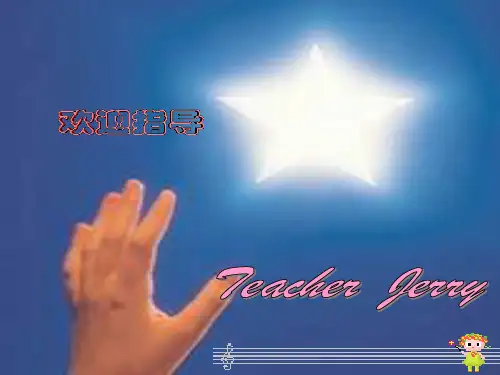
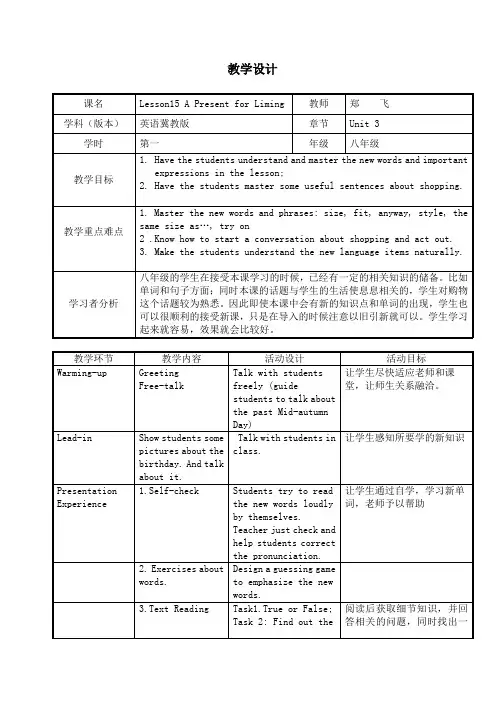
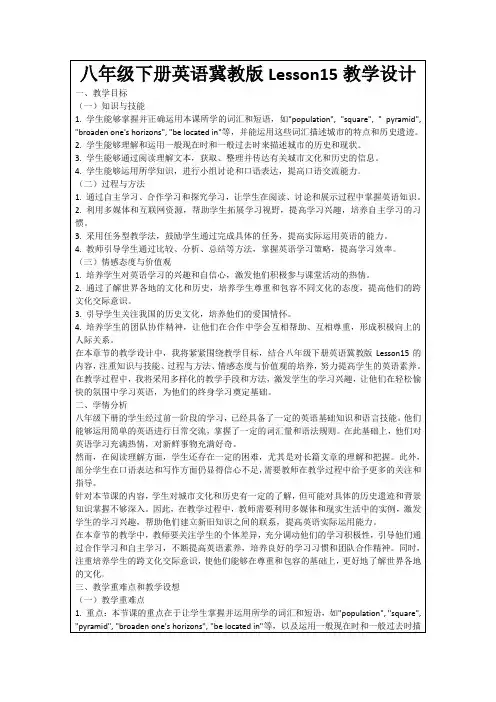
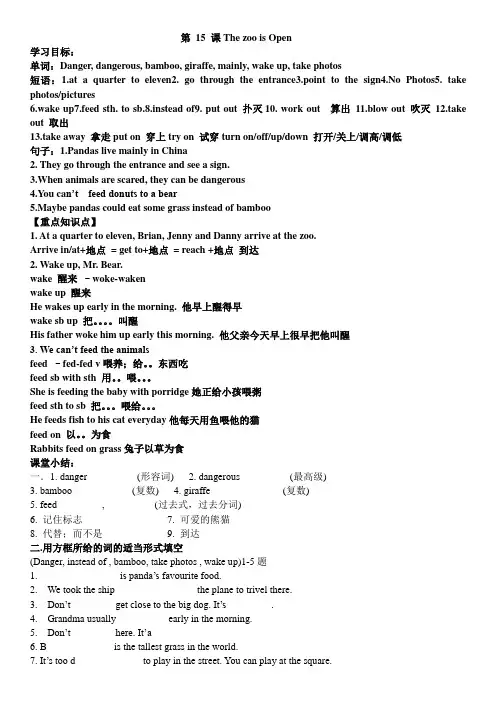
第15 课The zoo is Open学习目标:单词:Danger, dangerous, bamboo, giraffe, mainly, wake up, take photos短语:1.at a quarter to eleven2. go through the entrance3.point to the sign4.No Photos5. take photos/pictures6.wake up7.feed sth. to sb.8.instead of9.put out 扑灭10. work out 算出11.blow out 吹灭12.take out 取出13.take away 拿走put on 穿上try on 试穿turn on/off/up/down 打开/关上/调高/调低句子:1.Pandas live mainly in China2. They go through the entrance and see a sign.3.When animals are scared, they can be dangerous4.You ca n’t feed donuts to a bear5.Maybe pandas could eat some grass instead of bamboo【重点知识点】1. At a quarter to eleven, Brian, Jenny and Danny arrive at the zoo.Arrive in/at+地点= get to+地点= reach +地点到达2. Wake up, Mr. Bear.wake 醒来–woke-wakenwake up 醒来He wakes up early in the morning. 他早上醒得早wake sb up 把。
叫醒His father woke him up early this morning. 他父亲今天早上很早把他叫醒3. We can’t feed the animalsfeed –fed-fed v喂养;给。
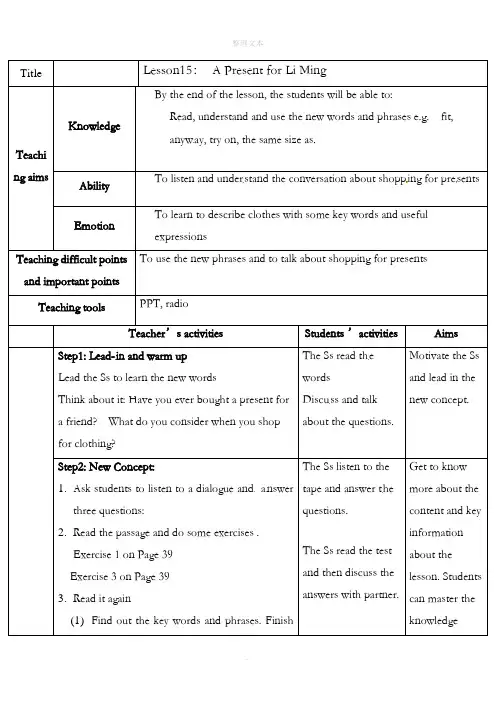
Title Lesson15:A Present for Li MingTeachi ng aims KnowledgeBy the end of the lesson, the students will be able to:Read, understand and use the new words and phrases e.g. fit,anyway, try on, the same size as.Ability To listen and understand the conversation about shopping for presents EmotionTo learn to describe clothes with some key words and usefulexpressionsTeaching difficult pointsand important pointsTo use the new phrases and to talk about shopping for presents Teaching tools PPT, radioTeacher’s activities Students ’activities AimsStep1: Lead-in and warm upLead the Ss to learn the new wordsThink about it: Have you ever bought a present for a friend? What do you consider when you shop for clothing?The Ss read thewordsDiscuss and talkabout the questions.Motivate the Ssand lead in thenew concept.Step2: New Concept:1.Ask students to listen to a dialogue and answerthree questions:2.Read the passage and do some exercises .Exercise 1 on Page 39Exercise 3 on Page 393.Read it again(1)Find out the key words and phrases. Finish The Ss listen to thetape and answer thequestions.The Ss read the testand then discuss theanswers with partner.Get to knowmore about thecontent and keyinformationabout thelesson. Studentscan master theknowledgesome sentences with the phrases.try onthe same size asfit…wellbuy…for(2)Fill in the blanks. Finish a dialogue withpartners. The Ss read it for thesecond time and getthe key words andphrases.Then fill in theblanks.throughlearning,studying.Students canget more andmore practiceby doing.Step3: Outward boundAt a clothing store. The clerk will say: At a clothing store. You will say:The Ss discuss thetopic and thenshare theirideas.(Give them twominutes to discussthe question).Students cangrasp importantphrases toexpressshopping forpresents.Step 4: Pair workTo act out the dialogue of buying and selling. It’s the Ss turn to talk about their dialogues. Ask some pairs to act them out. The Ss talk abouttheir dialogues andact them out.To give Ss timeto prac-tice theirlistening andspeakingabilities.Step5: SummaryTo help and love each other. Emotion promotion.Home-work 1.Retell the text orally.2.Write down the dialogue you have made in theclass.3.Find more ways to express shopping.Board DesignLesson15 A present for Li MingWords: Phrases:size try onfit fit…wellanyway the same size asstyle buy…for…。
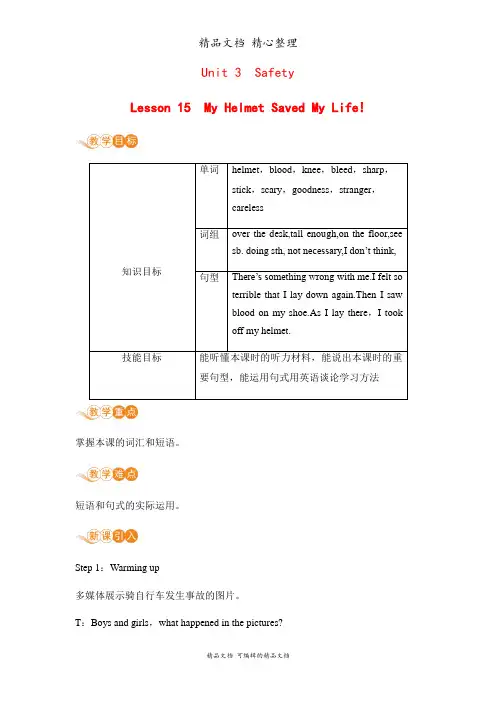
Unit 3 SafetyLesson 15 My Helmet Saved My Life!单词helmet,blood,knee,bleed,sharp,掌握本课的词汇和短语。
短语和句式的实际运用。
Step 1:Warming up多媒体展示骑自行车发生事故的图片。
T:Boys and girls,what happened in the pictures?Ss:It is a bike aident.T:Yes. Can you describe them?S1:Yes. The aident happened on a road.S2:A boy was riding his bicycle. All of a sudden,...T:OK. Well done!Now this lesson we will learn a bike aident. Are you ready?设计意图:此环节利用图片,通过师生问的对话导入本课的话题自行车事故,利用会话将学生带入自行车事故的场景,为下面的学习做好铺垫。
Step 2:Pre-readingTask 1 在屏幕上呈现本课的生词,让学生根据旁边的图片,学习本课的生词helmet,blood,knee,bleed,sharp,stick,scary,goodness,stranger,careless。
老师领读。
对新单词和一些延伸的词组可以给出提示。
Task 2教读这些单词,并且让学生齐读。
然后采用抢答来进行抽查:What’s missing?要求学生观察屏幕上的生词,快速说出不见的那个生词,直接起立抢答。
抢先且答对可以给所在组加分。
设计意图:向学生展示本课的重要词汇以及它们所处的情景,帮助学生学习新单词,为下面课文的学习做好准备。
Step 3:While-readingTask 1 Read the lesson and do Exercise 1 on Page 39.Task 2 Read the article aloud after the recorder.Let the students listen to the tape and repeat it sentence by sentence,then let the students read it aloud by themselves.给学生播放录音,学生跟读,学生起立模仿,小组间进行竞争,评出“朗读之星”。
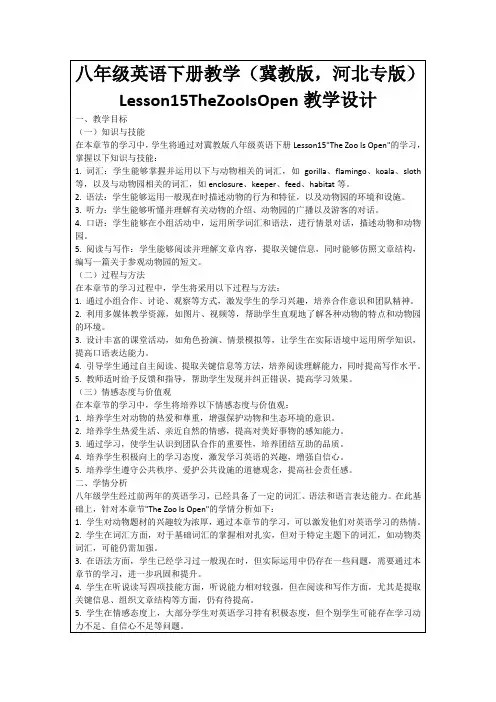
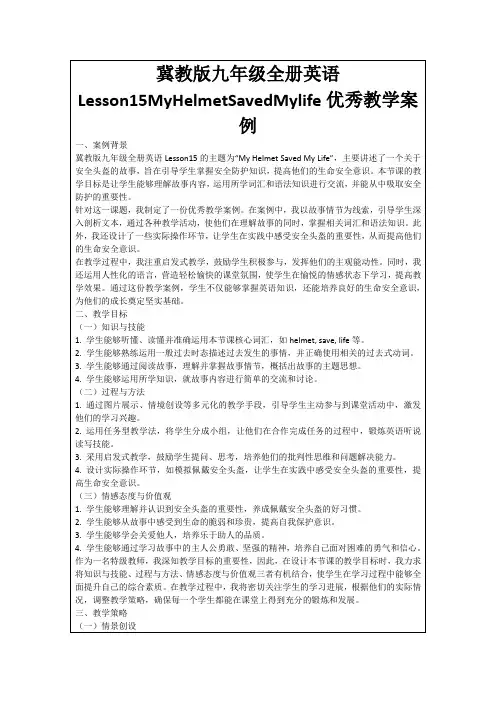
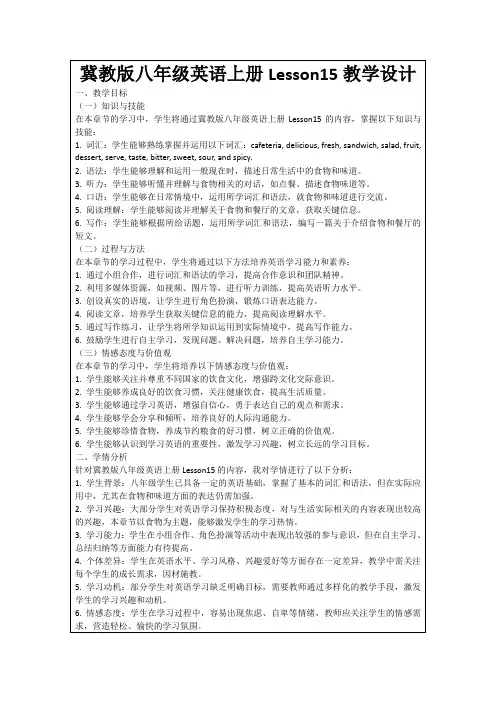
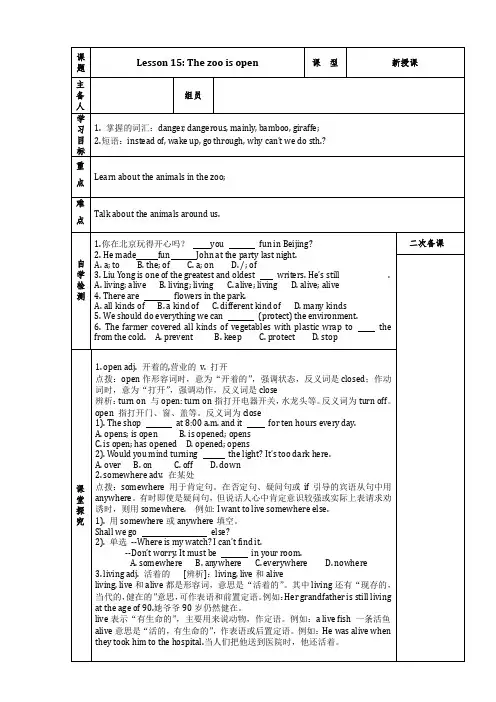
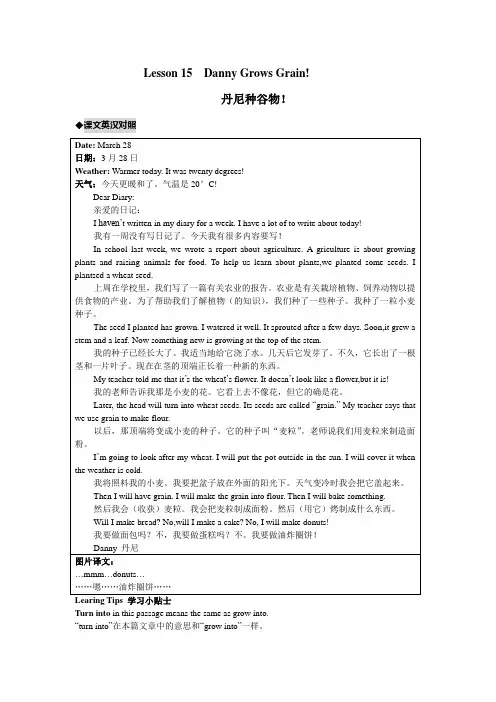
Lesson 15 Danny Grows Grain!丹尼种谷物!Learing Tips 学习小贴士T urn into in this passage means the same as grow into.“turn into”在本篇文章中的意思和“grow into”一样。
LET’S DO IT! 做一做!●Play a game! “Word Race” is a competition between two groups. Which group can name more plants in Engelish? Which group can do it faster? Write the plant names on the blackboard one by one.做游戏!“单词比赛”是两个组之间的比赛。
(看)哪个小组能用英语说出更多的植物名称?哪个小组做得更快?把植物的名称一个接一个地写在黑板上。
◆重点难点详解1.I haven’t written in my diary for a week. 我有一个星期没写日记了。
⑴该句用了现在完成时的否定形式,现在完成时态的结构是have/ has +过去分词。
现在完成时态表示在说话之前已经完成或结束的动作;它强调过去的动作对现在造成的影响及结果。
它不能与表示过去的时间状语连用。
●—I’ve read the newspaper today. 我今天看过报纸了。
●—I haven’t seen him for long. 我好久没看见他了。
⑵现在完成时也可以表示某一动作从过去开始一直持续到现在的情况,常与for,since等短语连用,此种用法中的动词须是延续性的动词。
在此用法中,短暂性动词可用于否定句中。
●—He has learned English for 3 years. 他已学了三年英语。
●—We have known each other for over 10 years. 我们彼此认识十多年了。
冀教版英语教学设计八下一、教学目标1. 听说:通过本单元的学习,学生能够听懂并正确运用与购物相关的日常用语。
2. 读写:学生能够正确理解并运用本单元所学的单词和短语,能够正确书写并运用重要句型。
3. 综合能力发展:培养学生的听说能力,增强他们的语言交际能力和跨文化交际能力。
二、教学重点与难点1. 教学重点:学生能够听懂并正确运用与购物相关的日常用语。
2. 教学难点:学生能够正确理解并运用本单元所学的重要句型。
三、教学准备课件、录音机、图片、单词卡片、小黑板等。
四、教学过程Step 1:导入新课(5分钟)1. 教师与学生打招呼,询问学生的近期购物经历,引入本单元话题。
2. 教师出示图片,让学生尽量用英语描述图片中的商品。
Step 2:新课学习(30分钟)1. 听力训练(1)播放录音,让学生听一段对话,理解并回答相关问题。
(2)教师与学生一起复习并运用对话中的日常用语,如“How much is this?”等。
2. 词汇学习(1)教师出示单词卡片,引导学生认读单词,并进行拼写和发音练习。
(2)师生一起讨论单词的义项,并进行词语搭配练习。
3. 句型学习(1)教师出示重要句型,通过示范和让学生模仿的方式学习句型的用法。
(2)学生们进行角色扮演,使用所学句型进行购物对话练习。
Step 3:听力训练(15分钟)1. 教师播放录音,学生们仔细倾听并完成听力练习。
2. 学生们模仿录音中的对话进行朗读,加强语音语调训练。
Step 4:拓展活动(20分钟)1. 听力巩固练习教师设计一系列购物场景,播放录音让学生们根据录音内容选择正确的答案。
2. 角色扮演学生们分成小组进行角色扮演,模拟真实的购物情景对话,并进行表演。
Step 5:作业布置(5分钟)1. 词汇练习:学生们完成课后练习册中与本单元词汇相关的练习。
2. 写作训练:学生们写一篇关于自己购物经历的短文。
五、教学反思在这堂课中,我充分利用了多媒体和互动的教学手段,使学生更好地参与到课堂中,提高了他们的学习兴趣。
冀教版8年级英语下册Lesson 15 The Zoo IS Open 教案教学过程一.预习检测1.danger(adj.)2. dangerous(反义词)3.bamboo(复数)4.giraff (复数)5.grass(复数)6.main(adv.)7.scared(vt.) 8.几乎(adv.) 9.处于危险 10. 脱险 11. 禁止拍照12.11:4513.如此可爱 14. 对……有益二.Listen to the tape and answer questions.1.Can they take photos? Why?2.Can Danny give donuts to a bear?三. Read the lesson and tick the correct answers.1. What day is today?Saturday Sunday2. Where do they go?The zoo. The park.3. What time is it when they arrive?11:15 a.m. 10:45 a. m.4. What do they see at the entrance?A photo. A sign.5. What animals do they see?A bear and a panda.A bear and some giraffes.四.语言点:1.The zoo is open! 动物园开放啦!open adj. 意为“开放,营业”。
The new store will be open in this spring. 新商店将在春天营业。
When was the zoo open? 动物园什么时候开放?open作形容词,意为“开着的,开阔的”。
反义词closed (关着的)。
open 作动词,意为“打开”,反义词为close/ shut(关上)。
冀教版8年级英语下册Lesson 15 The Zoo IS Open 教案教学过程一.预习检测1.danger(adj.)2. dangerous(反义词)3.bamboo(复数)4.giraff (复数)5.grass(复数)6.main(adv.)7.scared(vt.) 8.几乎(adv.) 9.处于危险 10. 脱险 11. 禁止拍照12.11:4513.如此可爱 14. 对……有益二.Listen to the tape and answer questions.1.Can they take photos? Why?2.Can Danny give donuts to a bear?三. Read the lesson and tick the correct answers.1. What day is today?Saturday Sunday2. Where do they go?The zoo. The park.3. What time is it when they arrive?11:15 a.m. 10:45 a. m.4. What do they see at the entrance?A photo. A sign.5. What animals do they see?A bear and a panda.A bear and some giraffes.四.语言点:1.The zoo is open! 动物园开放啦!open adj. 意为“开放,营业”。
The new store will be open in this spring. 新商店将在春天营业。
When was the zoo open? 动物园什么时候开放?open作形容词,意为“开着的,开阔的”。
反义词closed (关着的)。
open 作动词,意为“打开”,反义词为close/ shut(关上)。
The door is open. 门是开着的。
She keep the door open. 她把房门敞开着。
Open the windows and let some fresh air in. 打开窗户,让新鲜的空气进来。
2. They go through the entrance and see the sign.辨析:介词through 与acrossacross意为“横穿”,指从一边到另一边,强调动作是在表面进行。
through“在...之中,透过”的意思,主要表示从物体内部穿过。
如穿过森林、隧洞等。
区分:cross 作动词用,“穿过,越过”的意思。
主要表示在物体表面上横穿。
与go across同义。
1.We must ________ the road very carefully.2.Before going _________ the road, you should look left first and then right.3.Look! The man is swimming _______ the lake.4.The sunlight comes _______ the glass.5.He _________ the road and then comes to the post office.6.The two friends were walking _______ the forest.3.He points to the sign.他指向指示牌。
point to与 point at 的区别1)point to 意为“指向”,表示指向离说话人较远的事物,着重于指的方向。
He pointed to the house on the other side of the river and said, “that is my home ! ”他指向河对岸的房子说:“那是我家!”2)point at 意为“指着”,表示指向离说话人较近的事物,着重于指的对象。
Don’t point at the words while you are reading. 读书时不要用手指着字。
4. Why we can’t take photos?为什么我们不能拍照?take a photo (picture) /photos (pictures)拍照注意:take a photo of sb. 给某人拍照( 相片上有这个人),take a photo for sb. 给某人拍照( 相片不一定有此人)I want to take a photo/ picture of you. 我想给你拍照。
5. You can’t feed donuts to a bear! 你不能把面包圈为给熊吃!feed vt. & vi. “喂养,饲养”。
其过去式和过去分词是fed。
主要有以下用法:1)feed sth. to sb. 把某物给某人She fed milk to her baby. 她给宝宝喂了奶。
2) feed sb. on / with sth. 用某物来喂养某人She fed the baby on / with milk. 她喂宝宝牛奶。
3) feed on sth. “以……为食”,feed做不及物动词,此用法只用于动物,表人类“以……为食”用live on。
Tigers feed on meat. 老虎食肉。
Chinese people live on rice. 中国人以大米为主食。
注:当“以……供给……”解时,feed只可用with而不用on。
He fed the stove with firewood. 他往炉子里加柴火。
6.Maybe the panadas could eat some grass instead of bamboo. instead意为“代替”“替代”,作副词用,通常位于句尾。
如位于句首时常用逗号与后面阁开。
instead 在顺接句子中作“代替”讲,而在转折(或逆转)句子中作“然而”讲。
Lily isn't here. Ask Lucy instead.instead of是介宾短语,其意与instead相同,不同之处在于它后面常接宾语,其宾语多由名词、代词、介词、短语、动词 + ing 形式充当。
We'll ask Li Mei instead of Mary.1)Peter is seriously ill.So I will attend the meeting_____.A insteadB instead himC instead ofD insteads of2)You should do some exercise _____staying at home all the time.A insteadB butC instead ofD so体验:instead 与instead of 的转换1) He didn't answer me, instead, he asked me another question → H e asked me another question instead of answering me.2) I’ll of instead of her.→She won't go. I’ll go instead.7.Zoos help stop animals from going extinct. 动物园帮助阻止动物灭绝。
stop sb. from doing sth. 阻止某人做某事,Parents should stop their children from telling lies.父母亲应制止孩子们说谎。
同义词组有:prevent … from doing sth. 和keep… from doing sth.小结动词stop的用法:stop...from+v.-ing “阻止”“阻拦”“阻止……做某事”。
stop to do sth. “停下来做某事”,强调停下来去做另外一件事。
stop doing sth. “停止做某事”,强调停止正在做的事情。
We are tired. Let's stop __(have) a rest.When the teacher came in, the students stopped __; when the teacher went out , the students stopped to__(talk).五练习:ⅠFill in the blanks.1. In time of war a soldier's life is full of d______.2. My l____ brother never cleans his room.3. I was _____ (几乎) killed in the accident.4. Please _____ ____ _____ (不要拍照) at the zoo.5. ______ __ doing it himself, he got a man to do it.Ⅱ.单项选择1.The library __. It __ at 8:30 am. Every day.A.open; opensB. is open; is openC. is open; opensD. opens; is open2.Let’s go swimming __ going hiking, shall we?A.as well asB. in order toC. in addition toD. instead of3. What sign is often found in a museum? –“__ ”.A.MENUB. THE SIDE UPC. PAUSE C.NO PHOTOS4.The heavy rain stopped people from __ out.A.goB. to goC. goingD. goes5. These animals are in danger of __ .A.disappearB. disappearingC. disappearsD. disappeared6. “That’s the way to the nearest shop,” the little girl pointed __ the left.A. atB. toC. inD. for 六.Homework1. Review Lesson 16.2. Write a story about your trip to the zoo.. .。